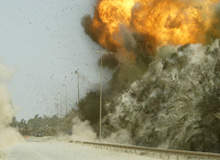
Improvised explosive devices (IED) have become a significant threat, in particular to international forces in Iraq and Afghanistan (the majority of casualties among coalition forces operating in Afghanistan are caused by IEDs). The homemade bombs come in countless shapes, sizes and techniques, using all kinds of explosives.
In order to prevent further attacks the member states of the European Defence Agency (EDA) will jointly buy a deployable field laboratory for the forensic research of road-side bomb explosions to enable forensic analysis of IED incidents. The system will be put out to tender, bought off the shelf and is planned to be operational by mid-2011. Afterwards it will be tested in a real operational environment by France, the project’s lead nation.
Understanding the IED scenario
“It is important to understand the chemical basis of IEDs and the scenarios of these particular threats in general,” explains Dr Peter Kaul of the University of Applied Science at Bonn-Rhine-Sieg in Germany.
Since 2004 Kaul’s institute at Rheinbach near Bonn has also been working in this area in cooperation with different scientific institutions of the German military. Part of this research about IEDs and other homemade bombs deals with the specific chemical signature of each bomb’s explosive materials.
See Also:
“One could say that we are looking for the chemical fingerprints of the different explosives,” said Kaul. “We must also get to know how large the individual traces of these substances have to be, so that we will still be able to detect them.”
How well do you really know your competitors?
Access the most comprehensive Company Profiles on the market, powered by GlobalData. Save hours of research. Gain competitive edge.

Thank you!
Your download email will arrive shortly
Not ready to buy yet? Download a free sample
We are confident about the unique quality of our Company Profiles. However, we want you to make the most beneficial decision for your business, so we offer a free sample that you can download by submitting the below form
By GlobalDataThe everyday use of detection methods on this basis would also depend on the knowledge of where, when, circumstances and in what quantity the typical chemical signatures appear and what their volatilisation time and spreading would be.
“We must also be able to differ between old and new traces as well as between real IED signatures and accidental contaminations,” Kaul said.
Under SISA, one of the university’s projects, methods will be developed for the quick identification of explosive materials and strategies for the detection of typical signatures of IEDs. Its aim is to define the spreading and behaviour of chemical signatures that originate from such devices. This information can then be used as a basis for new detection methods and strategies.
Improved testing of detection system
Such knowledge will help the military evaluate the military use of new detector systems better and more quickly. SISA is to develop a mobile method to detect explosives apart of their individual consistence.
This could be done with the help of verifying their exothermic reaction, analysing the reaction products or by determining their reaction time.
A method to investigate possible IEDs and other suspicious objects more quickly, which is being worked on in Rheinbach, is based on a miniaturised laser.
The project named Laser Techniques for the Detection of IEDs (LIED) tries to develop systems for mobile platforms that can penetrate unknown objects and analyse their content for explosives and other materials with the help of generated gas components.
Laser drilling and analysing system
The focus of the researchers lies on a laser-based intelligent drill technique to prevent accidental explosion of the materials, in particular, primary explosives. Such a system also needs means to analyse the gas components generated by the laser drilling.
“The final goal is a laser drilling and analysing system, could also include the capability to detect CBRN agents and be placed on a remote-controlled platform”, Kaul explained.
Even those projects will not be able to detect every IED or roadside bomb because one of the main advantages of IEDs is their flexibility in matters of shape or explosive materials. But a system for all scenarios simply does not exist according to the professor who says that momentarily only some explosives can be detected at the same time.
“Instead we have to find out which system is the best under which conditions, for example, materials, environment or time.”
Laser protection against RPG and mortars
Even if all IEDs and roadside bombs could be detected in operational areas such as Afghanistan, the threat of attacks with other relatively simple-to-handle weapons like shoulder-launched rockets or mortars would still exist. This is where laser technique might help in the future.
The EDA started the €4.2m Air Defence High Energy Laser Weapon (AD-HELW) research programme to counter RAM-targets (small targets such as mortar grenades or artillery rockets). The goal is to derive a conceptual layout for a laser weapon, which considers the interception of RAM-attacks in an urban environment.
Experimental and simulated testing
Until the end of 2011 the feasibility of such an effecter will be evaluated by experimental investigations, which is supposed to deliver the data on atmospheric influences on high energy laser beam propagation, on achievable target tracking accuracy and on the laser beam impact on such targets.
The efficiency of the laser weapon will also be analysed by system simulations, using the results of these experiments.
According to the EDA existent missile or cannon air defence systems would be well suited for the engagement of large targets such as aircrafts, but not for defence against RAM-targets. Opposite to this, high energy laser weapons would possess a short reaction time, high accuracy, a strong impact on the target, and the costs per shot would be low and cause no collateral damage.



